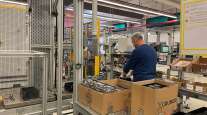Autonomous Driving, Connectivity Command Attention at IAA Show
This story appears in the Oct. 6 print edition of Transport Topics.
HANOVER, Germany — While fuel efficiency and safety were frequent topics at the 65th IAA Commercial Vehicles show, “autonomous driving” and “connectivity” were the unavoidable buzzwords.
The more than 2,000 global industry suppliers that exhibited at the Sept. 25-Oct. 2 event here continued the tradition as the place to display their visions of how trucking could look in the future, and based on that, it’s apparent that autonomous-driving trucks are coming.
“This is an interesting technology show, not just from the OEM side, but also on the supplier side, to show what is going on,” said Martin Daum, president of Daimler Trucks North America. “Every two years, the industry needs to see what [their suppliers] have in the pipelines.”
IAA takes place in even-numbered years and is considered the world’s largest trucking show. It is “a great way to showcase what is coming” and receive feedback on what could become the next great idea, Daum said. “IAA has captured that for Europe — second to none,” he said, adding that he believes the North American trucking industry should craft a similar event.
No announcement or product garnered as much attention as Daimler Trucks’ autonomous-driving “Future Truck 2025.”
PHOTO GALLERY: 2014 IAA Commercial Vehicles Show
Even though some OEMs and suppliers cautioned complete autonomous driving may not be realized in 10 years, they spoke of their technological developments that are creating a safer, more connected trucking industry and highway infrastructure.
DAF, the European arm of Paccar Inc., announced its own predictive cruise-control system would be available in combination with predictive shifting starting in January on some models.
Ron Borsboom, DAF’s chief engineer, said the system uses GPS to determine the position of the vehicle and looks several miles ahead to anticipate road changes.
Besides an expected gain in fuel economy, it can help advance “cooperative driving,” such as platooning systems being tested by a number of manufacturers that allow vehicles to automatically follow behind a lead truck.
While stressing much more research is required — as well as changes to existing regulations — “autonomous driving might be closer than one might think,” Borsboom said.
In the United States, Peterbilt Motors Co., also a unit of Paccar, recently presented a concept truck capable of autonomous driving, and Peloton Technology Inc. continued testing a platooning system.
Volvo Trucks and Scania Group each have worked on similar platooning projects for a number of years.
Bjorn Westman, head of Scania’s engine development, and Mikael Lundqvist, director of communications, told Transport Topics the company’s platooning project, which debuted a year ago, is continuing to show fuel-economy gains by reducing following distances between trucks.
Additionally, Scania has a concept truck that self-drives up to 40 mph before alerting the driver to take back control.
“Technology is not the limit” for the growth of autonomous driving, Lundqvist said. “It is the regulations and insurance questions.”
Wabco Holdings presented products including an advanced emergency braking system, lane-departure warning with driver drowsiness alert and a new modular braking system platform.
CEO Jacques Esculier said these are part of “a system that ultimately could lead to automated driving.”
Esculier cautioned additional breakthroughs are required before autonomous vehicles could offer enough value to fleets. He added: “Wabco will be there when it gets here.”
Continental AG executives were more bullish on the 2025 timeframe for self-driving trucks, focusing on its eHorizon system, which they said would be a key element “on the path to the fully automated vehicle.”
The system can leverage enhanced navigation data and topographic maps to better alert the vehicle of the road ahead.
“The eHorizon of the future will simplify anticipative driving and act as the basis for countless other technological developments,” said Michael Ruf, head of Continental’s commercial vehicles and aftermarket business unit.
Delphi Automotive PLC showed the second generation of its “technology truck” fitted with vision and radar sensors, and fuel injection systems.
“In the next 10 years, we are going to see extraordinary things that happen with the safety and connectivity of vehicles,” said Jeff Owens, Delphi’s chief technology officer. “These two areas are converging, but they must do so safely and efficiently.”
Owens said vehicles’ systems will one day reduce accidents and emissions by 50% and boost fuel economy. Additionally, Delphi said its advanced Ethernet connectivity enables vehicle systems on the truck to communicate and share information at a speed of 100 megabits per second.
Elsewhere, drivetrain and chassis maker ZF Friedrichshafen AG displayed its “Innovation Truck” with an automatic transmission and telematics that can be remotely maneuvered using a tablet computer.
Eight-time IAA attendee Mike Pennington, an industry veteran who is managing director of PenNotes, summed up the show as the place where the “latest and greatest [products and ideas] are shown.”
In the public areas, Pennington said there always is a bit of gamesmanship to impress among competitors. Behind the scenes, he said, several suppliers told him of bringing in key customers and partners from different markets for private demonstrations and “to see the global nature of the business.”
Pennington also said the pace of innovation among commercial vehicle suppliers continues to accelerate, comparing it with the automobile industry reacting to consumers’ demands.




